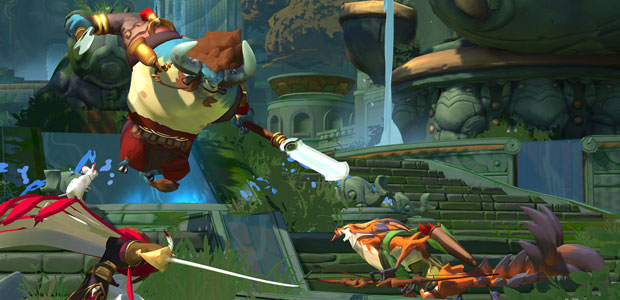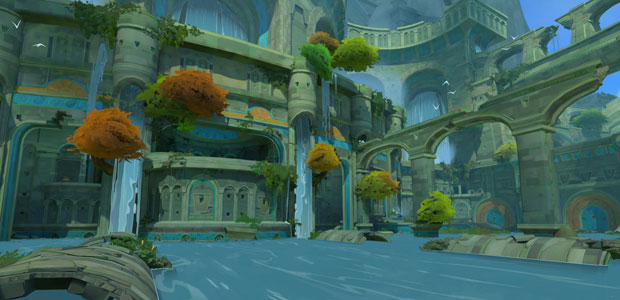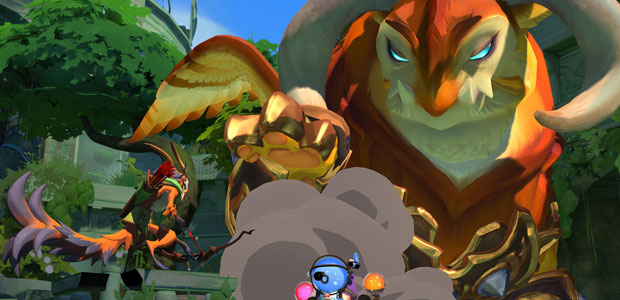StarCraft's James Phinney On New Project Gigantic
A chat about gigantic monsters
Hello, fans of shooter hybrids. Today we will be talking about Gigantic. Developers Motiga are referring to it as a "third-person shooter and action game with strong strategic elements". What that means in real terms is two teams of five each trying to protect their enormous Guardian creature while attempting to destroy their opponents' Guardian. To find out more I email-interviewed creative director James Phinney, whose name you might already know what with previous credits including being lead designer and producer on StarCraft and lead designer on Guild Wars. Let's start with exactly what Gigantic is and how it works.
RPS: So, tell me about Gigantic - what's the basic premise and what does your creative director role mean in relation to the game?
Phinney: In a fabled empire battles are waged alongside massive magical creatures: the Guardians of the land. Five heroes team up with a giant, hundred foot tall guardian to defeat the enemy team’s guardian. Combat is fast-paced and emphasizes player skill, using a combination of third-person shooter controls and action-RPG mechanics. Working as a team and making strategic adjustments are as important as dodging well and shooting straight
Being creative director means setting the tone and direction for Gigantic and working with everyone here to keep us all moving in the same direction. Sometimes that’s about having ideas and leading the way, but there are plenty of times when it’s about listening and getting out of the way. I try to create a very collaborative environment for myself and for the team as a whole. That means earning the respect of your peers every single day and knowing how to genuinely listen to feedback without letting fear or ego get in the way. Collaboration always sounds nice in principle, but the truth is that it isn’t always easy in practice. It’s not a very natural human thing to do. Fortunately, the team here is very experienced and talented. They believe in the game and they believe in each other. That helps.
RPS: From what I've read it sounds like it has a lot in common with a MOBA like Smite or LoL but the difference is the unit you're trying to protect is active and mobile rather than static and hidden in a base - can you tell me more about how that idea came about?
Phinney: Gigantic draws from a lot of different influences. There are a handful of key mechanics that are straight out of the traditional MOBA playbook, but the comparisons don’t hold up from there. Gigantic is a third-person shooter and action game with strong strategic elements and an emphasis on teamwork. Playing it, you’ll find that the moment-to-moment gameplay and the strategic decisions you make aren’t akin to a traditional MOBA at all.
I could make a list: All abilities require aiming, there are no lanes, traditional character roles have been ignored, there are no creep waves or towers or items to buy, gameplay makes strong use of the three-dimensional space, environmental destruction, and physics interactions. The list isn’t what matters, though. It’s not that we’re specifically trying to break the mold; it’s that the MOBA model isn’t the foundation for Gigantic.
The game started as a competitive action RPG and evolved from there. From the start, we knew we wanted to heavily feature giant boss monsters and that quickly became the core concept of fighting with a guardian to defeat the enemy guardian. From there we looked at the other elements that we thought would make it a great PvP experience. Lessons from previous projects guided me initially, along with a love for a certain kind of in-your-face action gameplay. We moved quickly into prototyping and got excited about the potential of these ideas right away.
RPS: What design challenges does that offer up in terms of balancing maps and so on?
Phinney: Every project is a learning process. You know what you think should work, and how you’ll approach the problems that you haven’t yet solved, but you have to be open to earning some wisdom the hard way too. The Guardians definitely add another dimension to consider when making the maps, but we can look at some traditional console boss monster environment design there. Some of the trickier lessons we’ve had to learn had to do with character mobility and combat sight-lines, and with the mix of melee and ranged combat. And of course, the strategic flow of the game and the impact of environmental destruction have evolved a lot of the course of the last year. Every week is a chance for us to get better at making this game.
RPS: What stage are you at with the alpha? Number of heroes, systems, maps - that sort of thing...
Phinney: We know that the challenges in a PvP game aren’t whether or not you can create enough stuff. The true challenge is making sure that everything you created meshes together perfectly. Balance and pacing are essential. We believe you need a commitment to playtest and to listening to feedback. That doesn’t mean responding in a knee-jerk way to comments that you get, but it does mean always being open to players’ experiences and insights.
So for us, the primary goals right now are ensuring that we have confidence in the game overall and that we’re in a position to continually adapt and make the game better. As far as that goes, we’re feeling very good. If you play the game today, you’ll (mostly) have fun and (mostly) understand what we’re trying to do. You’ll also recognize that the game’s not a finished product, and you’ll hope that we’re going to keep improving it. We will.
As for numbers, the current alpha build features 14 heroes. Our internal builds have 20. We’ve started work, to one degree or another, on ten more. For maps, there are two in the current alpha build and about a dozen that we’ve played internally. (Most of those have been terrible for one reason or another and were thrown out in the prototyping stage.) Four maps are currently in active rotation for our internal tests.
RPS: What kinds of hero are we talking about in Gigantic? Tell me about your favourite and how they work.
Phinney: We think of the heroes in terms of players and play styles. For example, there are a number who have ranged projectiles as their primary attacks, but a couple of these are meant for shooter players (HK-206 who has a gun for every occasion, and Imani, who is a sniper) while others draw more from action games (Roland, with his grappling hook and blunderbuss) or RPGs (Voden, who summons a decoy, creates poison clouds, and focuses more on skill interactions).
My personal favorite varies from day-to-day depending on my mood. I do tend to like heroes that give me an opportunity to outwit an opponent and make up for my ever-slowing reflexes. Vadasi, who has to sacrifice her own health to help out allies or for a temporary combat boost, suits me pretty well. Roland’s hit-and-run tactics, and Voden’s trickery also appeal to me. Some days, though, I want to just be tough like the Margrave, to melt people with Charnok, trample them with Lord Knossos, or play healer as Uncle Sven.
RPS: Does the game use items to augment hero abilities?
Phinney: No, not at all. You have many choices about how you upgrade your hero as each battle progresses, but they’re expressed as trait and skill upgrades. You get the chance to upgrade as you level up. There’s no gold or anything like that and no store to navigate or items to buy or use. The upgrades aren’t simply stat increases. We really try to give you the opportunity to change the functionality of your skills so that you have a chance to adapt to the battle you’re in, choosing upgrades that help with the hero match-ups you’re facing and that let you take on the role that your team needs.
For example, as Voden, I can upgrade my Hidden Spring skill to be much, much better at healing, but I can also upgrade it to “burst forth” when it appears and knock away nearby enemies. Depending on who I am facing or what my team needs from me, I’ll go one direction or the other.
RPS: I saw an update from a couple of months back and it mentioned competitive gaming - how are you pursuing or approaching that?
Phinney: There’s a strong feature set that’s required to make that a possibility (spectator, tournaments, etc.), but the foundation is the core of the game itself: First, you need to create the potential for the fun, the challenge, the depth, and the balance necessary to be work as a competitive game. I say ‘potential’ because at the early stages, your balance and mechanics shift a lot. It’s not the individual adjustments that matter as much as make sure you’re creating a toolset so that you can actually balance the game in the long run. (Though you don’t want balance to ever be terrible either. Whenever that happens -- and it will happen -- you need to address it quickly.) That toolset includes the mechanics and pipeline for the game, the analytics capability of your team, and your relationship with your player community. Outside perspective is key if you want to succeed.
RPS: How have your previous experiences been of use here (StarCraft's longevity and competitive scene are well known, but Guild Wars had a competitive scene too)?
Phinney: There are a lot of specifics in terms of pacing or mechanics and principles in terms of player freedom that come from those games and translate to the choices we’ve made on Gigantic. The strategic flexibility of StarCraft and potential for drops in the enemy base are part of the blueprint for Gigantic. The fight for the center balanced by threat on the objective, plus the climactic rush of killing the enemy boss is very much drawn from the original Guild Wars. Both games also gave me a faith that gameplay could be fast and still ask players to think strategically.
But mechanics only tell part of the picture. If there’s one central lesson you have to learn as a game designer, it’s humility. If you let them help you, players will show you how to make your game better. That’s why we’re continuing to expand the alpha, and why we’re bringing it to Europe. We want to get even more players involved as soon as possible.
Gigantic will be launching its European alpha server on 17 December.



















